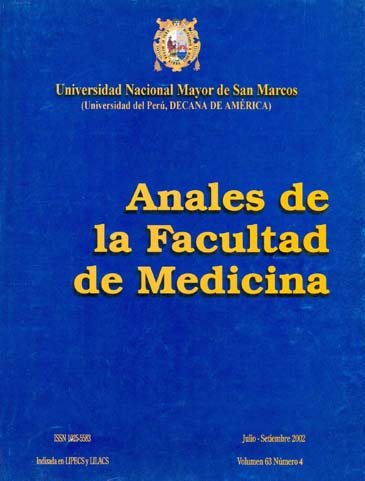Science of genome
DOI:
https://doi.org/10.15381/anales.v63i4.1509Keywords:
Genome, genome, human, DNA, proteins, genetic codeAbstract
The limited success obtained in February 2001 in USA by two teams (public and private) for sequencing the human genome (estimated total size 3,2 gigabases) open a new and broad scientific field. This is the science of genomic, a discipline that will lead to changes in knowledge and methodologies in many areas like medicine, immunology, genetics, biochemistry and others. Some basic characteristics of our genome have been identified by the Human Genome Project and the more importants are: the coding regions of the human genome represent about 1% of full-length DNA.The present or past function of the incorrectly named “junk DNA” is as yet unknown. Our genes are composed of coding (exons) and no-coding (introns) regions. The latter are significatively larger in our species that in any other genome yet sequenced. The regions rich in G-C pairs are also those which have a higher gene density and correspond mainly to poorly stained bands of chromosomes observed by microscopy. Also, several interactions and supplementary regions are observed in human genome. For human medicine and immunology this scientific exploit is beneficial. One thousand and one hundred genes pathogens for man were discovered by 2000 and an estimated twenty thousand genes are responsible for the human normal and pathologic immune responses. Proteomics and transcriptomics are linked with the genome analysis and their importance is growing for the genomic science.Downloads
Published
2002-12-30
Issue
Section
Revisiones
License
Copyright (c) 2002 ANTONIO CRUZ-CUBAS, LAURENCE ROLLAND-BURGER

This work is licensed under a Creative Commons Attribution-NonCommercial-ShareAlike 4.0 International License.
Those authors who have publications with this magazine accept the following terms:
- Authors will retain their copyrights and guarantee the journal the right of first publication of their work, which will be simultaneously subject to Creative Commons Attribution License that allows third parties to share the work as long as its author and its first publication this magazine are indicated.
- Authors may adopt other non-exclusive licensing agreements for the distribution of the version of the published work (eg, deposit it in an institutional electronic file or publish it in a monographic volume) provided that the initial publication in this magazine is indicated.
- Authors are allowed and recommended to disseminate their work over the Internet (eg: in institutional telematic archives or on their website) before and during the submission process, which It can produce interesting exchanges and increase quotes from the published work. (See El efecto del acceso abierto ).
How to Cite
1.
Cruz Cubas A, Rolland Burger L. Science of genome. An Fac med [Internet]. 2002 Dec. 30 [cited 2024 Aug. 16];63(4):281-90. Available from: https://revistasinvestigacion.unmsm.edu.pe/index.php/anales/article/view/1509















